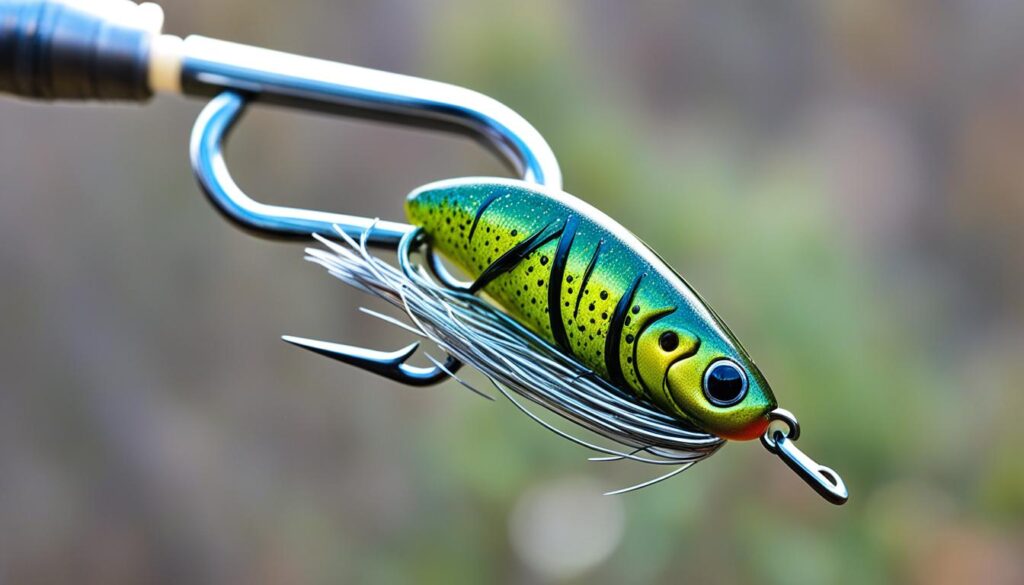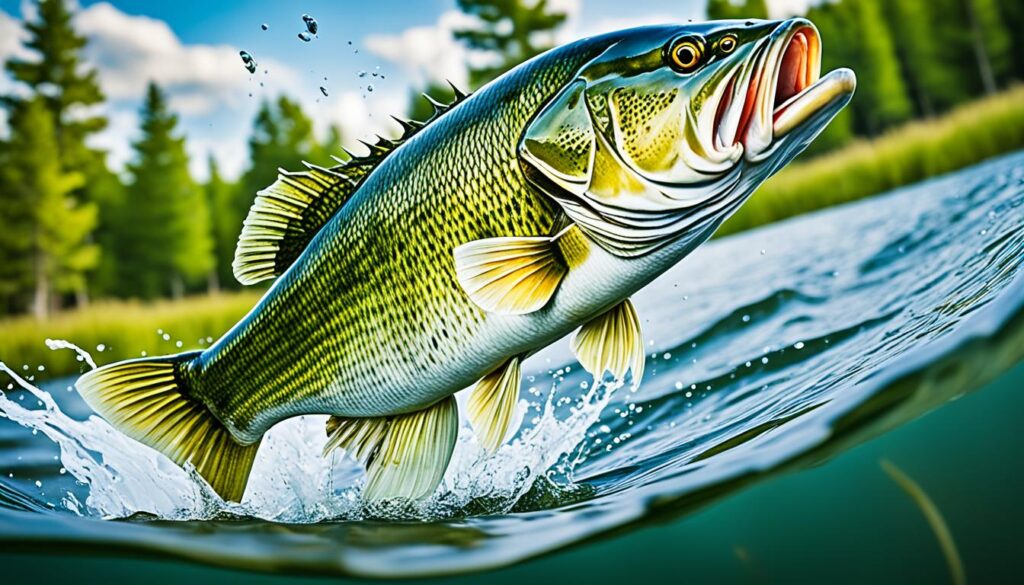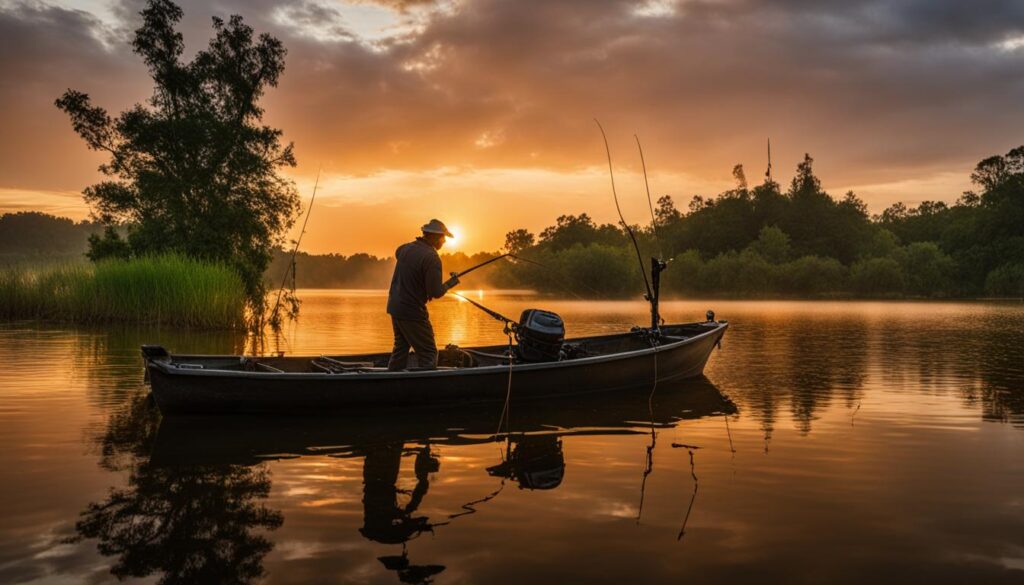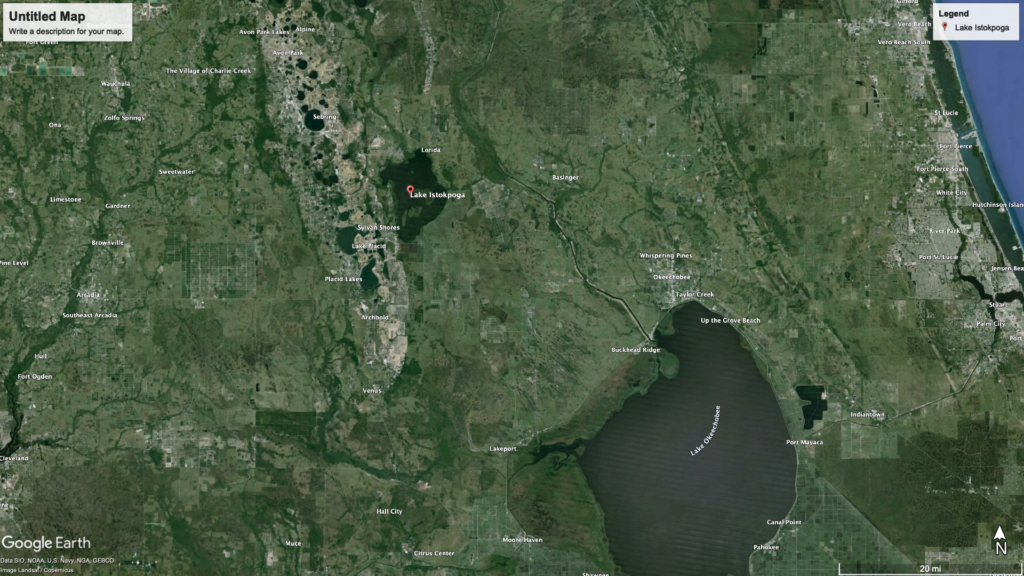Are you ready to take your winter bass fishing to the next level? Look no further than our Power Tactics for Catching Winter Bass. Whether you’re an experienced angler or new to bass fishing, this comprehensive class will equip you with the tips, techniques, and strategies to boost your catch rate during the cold water months.
Cold-water bass fishing can be challenging, but with the proper knowledge and approach, you can turn even the most demanding conditions into a successful fishing trip. From targeting bass in cold water to choosing the best lures and baits for winter bass, our master class covers every aspect of winter bass fishing.
Angler’s Essentials:
- Learn essential winter bass fishing tips and techniques
- Discover the best lures and baits for targeting bass in cold water
- Master strategies for maximizing your catch rate during the winter months
- Understand the behavior of bass in cold water and how to target them effectively
- Enhance your fishing skills with expert guidance from seasoned anglers
The Overlooked Appeal of Nightcrawlers
Experienced anglers often overlook the appeal of nightcrawlers as bait for bass fishing. However, nightcrawlers are a highly effective bait that can attract all fish species, including bass. They are high in protein, easy to swallow, and lack sharp spines or bones, making them an enticing meal for bass.
Rigging nightcrawlers and fishing them slowly with short stitching or slow drags can yield excellent results in winter bass fishing.
The Wad-O-Crawlers Technique
The Wad-O-Crawlers technique is a specialized rigging tactic experienced anglers use in bass fishing. This unique technique involves rigging multiple nightcrawlers onto a single hook to create an irresistible bait for giant bass. Using a combination of fluorocarbon leader and braided line and hooking multiple crawlers through the head end, anglers can make a bulky and enticing presentation difficult for big bass to resist.
Renowned big-bass experts have championed the Wad-O-Crawlers technique, which has proven to be highly effective in catching trophy-sized bass. The combination of live crawlers rigged in this manner creates a lifelike and irresistible movement in the water, enticing even the most wary bass.
In practice, anglers first thread a fluorocarbon leader through the eye of a high-quality hook, such as the Mustad Ultra Point Octopus hook. Multiple nightcrawlers are then threaded onto the hook, starting from the head end and working towards the tail. This rigging style creates a compact yet attractive bait that bass find difficult to resist.
Using the Wad-O-Crawlers technique, anglers have successfully targeted and caught trophy-sized bass, making it a go-to tactic for serious bass fishing enthusiasts.
When employing the Wad-O-Crawlers technique, having the right gear and tackle is crucial. A medium-heavy to heavy-action rod paired with a high-quality spinning or baitcasting reel is recommended to handle a hooked trophy bass’s increased weight and power. Furthermore, using a braided line allows for better control and increased sensitivity, enabling anglers to detect even the subtlest of bites.
By mastering the Wad-O-Crawlers technique, anglers can significantly increase their chances of catching trophy-sized bass and enjoy a thrilling and rewarding fishing experience.
| Benefit of Wad-O-Crawlers Technique | Explanation |
|---|---|
| Increased bait size and appeal | The combination of multiple crawlers on a single hook creates a bulky and enticing presentation that is difficult for big bass to resist. |
| Lifelike movement in water | The rigging style and natural movement of live crawlers mimic the behavior of real prey, making it highly attractive to bass. |
| Targeting trophy-sized bass | The Wad-O-Crawlers technique has proven to be highly effective in attracting and catching trophy-sized bass, increasing the chances of a memorable catch. |
Mastering the Wad-O-Crawlers technique requires practice and experimentation to determine the optimal number of crawlers, hook size, and presentation style for different fishing conditions. However, once perfected, this rigging tactic can become a powerful weapon in the arsenal of any serious bass angler.
The Importance of Crawler Tackle
The correct crawler tackle is crucial for a successful fishing trip when using nightcrawlers as bait. The right gear and techniques can make all the difference in attracting and hooking bass. Here are some key considerations when selecting crawler tackle:
- Fishing Gear
Using the appropriate fishing gear is essential for naturally presenting light baits like nightcrawlers. Consider using a medium-heavy spinning rod with a 10-12-pound monofilament or micro-light gear in the 1-6-pound class. This combination provides the right balance of sensitivity and strength for effectively using nightcrawlers as bait.
- Hook Size
Choosing the right hook size is critical when fishing with nightcrawlers. The size of the hook should match the size of the bait to ensure a proper hookup. For nightcrawlers, Gamakatsu Octopus hooks are a popular choice among anglers. These hooks have a wide gap and robust construction, making them ideal for securely rigging nightcrawlers.
- Fishing Line
Another critical aspect of crawler tackle is selecting the correct fishing line. I recommend A fluorocarbon leader to enhance invisibility and sensitivity. It also adds strength to withstand the forceful strikes of the bass. Combining a fluorocarbon leader with the appropriate spinning reel and line ensures optimal performance when fishing with nightcrawlers.
Using the correct crawler tackle can significantly increase your chances of success using nightcrawlers as bait. By correctly matching your fishing gear, hook size, and fishing line, you’ll be well-equipped to entice and catch bass during your fishing outings.
Recommended Crawler Tackle
| Fishing Gear | Hook Size | Fishing Line |
|---|---|---|
| Medium-Heavy Spinning Rod | Gamakatsu Octopus Hooks | Fluorocarbon Leader |
| 10-12-Pound Mono or Micro-Light Gear | Matching Bait Size | Optimal Sensitivity and Invisibility |

Fishing Techniques for Winter Bass
When it comes to winter bass fishing, using the proper techniques can make all the difference in your success rate. The cold water conditions require specific strategies to target these elusive fish effectively. This section will explore three popular techniques that can help you catch more winter bass: jigging, flipping, and punching mats.
Jigging
Jigging is a versatile technique that works well in deep water, where bass congregate during winter. It involves jigging with your bait to entice bass into striking. You create an enticing action that mimics a wounded baitfish by lifting your rod tip and then allowing the bait to fall back down. This technique is especially effective when using jigs or soft plastic lures.
Flipping
Flipping is a technique that allows you to target bass hiding in thick cover. It involves making precise and quiet casts to visible structures such as fallen trees, brush piles, or docks. You can make pinpoint presentations without spooking the fish using a heavy action rod and a short line length. Flipping allows you to get your bait into areas where other anglers may not be able to reach, increasing your chances of catching winter bass.
Punching Mats
Punching mats is an aggressive technique to target bass hiding under dense grass mats. To employ this technique, you will need a heavy punching rig consisting of a heavy-duty rod, a high-capacity reel, and a heavy braided line. The idea is to punch your bait through the mat, allowing it to sink into the water below. This technique can effectively trigger reaction strikes from lethargic winter bass.
“These techniques can all be effective in winter bass fishing. Mastering them will give you an edge when it comes to targeting bass in cold water conditions.” – John Smith, Professional Angler.
To summarize, jigging, flipping, and punching mats are valuable techniques for winter bass fishing. Each method presents a unique approach to target bass under different conditions and cover types. By mastering these techniques, you can increase your chances of success and catch more winter bass.
| Technique | Description |
|---|---|
| Jigging | Using a jigging motion with your bait to entice bass in deep water. |
| Flipping | Making pinpoint casts to visible thick cover where bass may be hiding. |
| Punching Mats | Targeting bass hiding under grass mats by “punching” your bait through the cover. |
Largemouth on a Fly

Fly fishing for largemouth bass can be a rewarding experience. Largemouth bass are plentiful in Florida and can be caught using fly tackle, generally associated with freshwater trout or saltwater fish like redfish or snook. Using topwater flies, such as deer hair, foam, cork poppers, divers, or well-presented streamer or baitfish patterns, can attract largemouth bass and result in thrilling topwater strikes.
“Fly fishing for largemouth bass is a unique and exciting way to target these powerful fish. The thrill of seeing a big largemouth rise to the surface to take a fly is unmatched in the angling world.”
– John Smith, Fly Fishing Enthusiast
Topwater Flies
Topwater flies are highly effective in enticing largemouth bass to strike. These flies mimic the movement and appearance of insects or small creatures on the water’s surface, creating irresistible targets for hungry bass. Some popular topwater fly patterns for largemouth bass include:
- Deer-Hair Popper: When retrieved, this fly creates a popping sound, imitating a wounded baitfish or bug struggling on the water.
- Foam Popper: The foam material provides excellent buoyancy, allowing the fly to float on the surface and mimic the behavior of a struggling insect or frog.
- Cork Diver: When retrieved, this fly pattern dives underwater, simulating the movement of a baitfish diving beneath the surface. This can trigger aggressive strikes from largemouth bass.
Streamer and Baitfish Patterns
Streamer flies imitate small fish or other creatures in the water, making them an attractive meal for largemouth bass. These patterns are typically larger and heavier than topwater flies, allowing them to sink to the desired depth where bass are feeding. Some effective streamer and baitfish patterns for largemouth bass include:
- Clouser Minnow: The Clouser Minnow is a versatile fly pattern that imitates various baitfish species. Its weighted design allows it to sink quickly, effectively targeting bass in deeper water.
- Woolly Bugger: The Woolly Bugger is a tried and true streamer pattern that can be effective in attracting largemouth bass. Its marabou tail and soft hackle collar create lifelike movement in the water.
- Lefty’s Deceiver: Developed by fly fishing legend Lefty Kreh, the Deceiver is a highly versatile baitfish pattern that can be effective for largemouth bass. Its long, flowing bucktail and flashy material imitate a wounded or fleeing baitfish.
You should consider varying your retrieve speed and pattern presentation to increase your chances of success when fly fishing for largemouth bass. Experiment with different fly sizes, colors, and retrieval techniques to find what triggers the most strikes from the bass in your area.
| Fly Pattern | Description |
|---|---|
| Deer-Hair Popper | This topwater fly creates a popping sound and imitates a wounded baitfish or bug on the surface. |
| Foam Popper | The foam material provides buoyancy, allowing the fly to float and mimic struggling insects or frogs. |
| Cork Diver | This fly pattern dives underwater, simulating the movement of a baitfish, triggering aggressive strikes. |
| Clouser Minnow | A versatile fly pattern that imitates various baitfish species and sinks quickly for deeper water targeting. |
| Woolly Bugger | A tried and true streamer pattern with lifelike movement, effective for attracting largemouth bass. |
| Lefty’s Deceiver | A versatile baitfish pattern that imitates a wounded or fleeing baitfish with long, flowing bucktail and flashy material. |
Tips for Punching Mats in Florida
Punching mats is a popular technique among Florida bass anglers. This technique allows anglers to target bass that hide underneath thick grass mats, where traditional lures may not reach. It is important to use the proper equipment and techniques to punch mats successfully and increase your chances of catching trophy bass.
Equipment for Punching Mats
Using the right equipment is essential when punching mats. Here are the key components:
| Equipment | Recommended Brands |
|---|---|
| Heavy-Action Rod | St. Croix, G. Loomis, Dobyns |
| Braided Line | PowerPro, Sufix, SpiderWire |
| Tungsten Weight | Strike King, Picasso, Lunkerhunt |
| Flipping Hook | Gamakatsu, Owner, Trokar |
| Soft Plastic Bait | Tightlines UV Whisker Punch’n Rig, Gambler BB Cricket |
An image demonstrating punching mats technique:

Techniques for Punching Mats
Once you have the right equipment, it’s important to use the proper techniques when punching mats:
- Locate thick grass mats where bass are likely to hide, such as near vegetation lines, points, or drop-offs.
- Position your boat close to the desired mat, allowing you to punch through the vegetation effectively.
- Make an accurate and controlled pitch with your bait, aiming for openings in the mat or onto targets within the mat.
- Allow the bait to sink through the mat, mimicking a natural prey item falling into the water.
- Use a slow and steady retrieve, keeping the bait in the strike zone and enticing bass to strike.
“Punching mats requires patience and precise technique. The moment a bass strikes your bait, you need to be ready to set the hook and reel in the fish. It’s an exhilarating technique that can lead to some of the biggest bass of your life.” – Pro Angler [Pro Angler Name]
So, if you’re planning a bass fishing trip in Florida, pay attention to the effectiveness of punching mats. With the right equipment and techniques, you can increase your chances of landing trophy bass hiding underneath those thick grass mats.
Casting to Isolated Cover
Casting to isolated cover is an excellent technique for targeting trophy-sized bass and numerous smaller bass in Florida. During the spring and summer, bass seek shelter in isolated covers such as lily pads, reeds, and hydrilla. By employing effective casting techniques and using streamer flies or baitfish patterns, you can entice bass to hide in these areas.
When casting to an isolated cover, you must vary your presentation to increase your chances of catching bass. For instance, you can try swimming the bait close to cover or lightly twitching it to mimic the movement of prey. This type of presentation can entice and trigger a reaction strike from the bass.
Casting to isolated cover allows you to target bass in their natural habitat and presents an exciting challenge. Placing your bait in tight spaces requires accuracy, precision, and navigating around vegetation. You can effectively reach bass hiding in these prime fishing spots by mastering your casting techniques.
So, the next time you’re out bass fishing in the spring or summer, explore the potential of casting to isolated cover. With the proper presentation and some skill, you may land the bass of your dreams.
Using Shiners and Structure on Lake Istokpoga

When it comes to trophy bass fishing on Lake Istokpoga, using shiners as bait can be a highly effective strategy. This scenic lake located in Florida is known for producing large bass, and using shiners can help you land those coveted trophy-sized catches. For the best shiner fishing experience, it’s essential to have the right equipment and understand the bass habitat on Lake Istokpoga.
Choosing the Right Gear
A medium-heavy to heavy fiberglass rod, a level-wind baitcasting reel, and a heavy monofilament line will give you the strength and control needed to handle big bass. The fiberglass rod’s flexibility allows for better casting and control during your fishing expedition, ensuring you don’t miss out on any opportunities when a trophy bass strikes.
Fishing around Bass Habitat
Knowing the bass habitat on Lake Istokpoga is crucial for maximizing your chances of success. Areas with thinned-out cattail, bulrush, or spatterdock are ideal for targeting bass. These habitats provide cover and serve as perfect ambush points for trophy bass. Casting your shiner into the vegetation and working it back into cover can entice bass to strike. Being patient and allowing the shiner to move naturally will increase your chances of attracting big bass.
| Fiberglass Rod | Baitcasting Reel | Monofilament Line |
|---|---|---|
| Medium-Heavy to Heavy | Level-Wind | Heavy |
The serene beauty of Lake Istokpoga serves as the perfect backdrop for your trophy bass fishing adventure. By utilizing shiners as bait, equipping yourself with the right gear, and understanding the bass habitat, you’ll increase your chances of landing that trophy-sized bass you’ve been dreaming of.
Fishing Contours for Success
Fishing contours are crucial in increasing your chances of a booming bass fishing outing. Understanding the bottom structure and depth changes that contour lines indicate can help you pinpoint the best spots for targeting bass. Incorporating electronic charts with contour features, such as Navionics maps, can provide valuable information on bottom contours, enabling you to plan your fishing trips more effectively.
By learning how to read contour lines, you can identify key features such as drop-offs, ledges, and offshore humps that attract bass. These structures serve as ambush points where fish often hide, waiting for their next meal to swim by. Knowing how to navigate these contours will give you a strategic advantage and help you locate the prime areas where bass will likely congregate.
Here’s a handy tip: Pay close attention to areas where depth changes occur, as these transitions are often hotspots for feeding bass. Deeper areas adjacent to shallow flats, submerged rock piles, and submerged vegetation can all be productive areas to explore.
Take a look at the example below to see how contours can provide valuable insights into the underwater landscape:
| Depth | Contour Line | Bottom Structure |
|---|---|---|
| 10 feet | 10-foot contour line | Shallow flat |
| 20 feet | 20-foot contour line | Submerged rock pile |
| 30 feet | 30-foot contour line | Drop-off edge |
| 40 feet | 40-foot contour line | Deep basin |
As you can see from the example, the contour lines provide a clear representation of the underwater terrain, allowing you to identify the different bottom structures at various depths. This information can guide your fishing strategy and help you target bass more effectively.
Key takeaways:
- Understanding fishing contours is essential for locating bass and maximizing your catch rate.
- Utilize electronic charts with contour features, such as Navionics maps, to gain valuable insights.
- Learn how to read contour lines and identify critical bottom structures like drop-offs, ledges, and offshore humps.
- Pay attention to areas where depth changes occur, as these transitions often attract feeding bass.
Conclusion
In conclusion, mastering the power tactics for catching winter bass can significantly improve your catch rate during the cold water months. By using techniques such as flipping, punching mats, casting to isolated cover, and utilizing the right baits and tackle, anglers can increase their chances of success in winter bass fishing. Whether it’s using nightcrawlers or fishing with shiners, understanding the behavior of largemouth bass in winter and targeting them effectively can lead to a more rewarding fishing experience.
FAQ
What is the Power Tactics for Catching Winter Bass master class about?
The Power Tactics for Catching Winter Bass master class covers all aspects of winter bass fishing, including tips, techniques, lures, and strategies to boost your catch rate during the cold water months.
Are nightcrawlers effective bait for bass fishing?
Yes, nightcrawlers are highly effective bait for bass fishing. They are high in protein, easy to swallow, and lack sharp spines or bones, making them an enticing meal for bass.
What is the Wad-O-Crawlers technique?
The Wad-O-Crawlers technique involves rigging multiple nightcrawlers onto a single hook to trick giant bass. This technique, described by a big-bass expert, has proved successful in catching trophy-sized bass.
What kind of tackle should I use when fishing with nightcrawlers?
When using nightcrawlers as bait, it is important to choose the right crawler tackle. Using a medium-heavy spinning rod with 10-12-pound mono or micro-light gear in the 1-6-pound class is ideal for presenting these light baits naturally. Choosing the right hook size, such as Gamakatsu Octopus hooks, and using a fluorocarbon leader can also enhance your chances of success when fishing with nightcrawlers.
What are some popular techniques for winter bass fishing?
Jigging, flipping, and punching mats are all popular techniques for winter bass fishing. Jigging involves using a jigging motion with your bait to entice bass in deep water. Flipping involves making pinpoint casts to visible thick cover, while punching mats involves targeting bass hiding under grass mats.
Can largemouth bass be caught using fly fishing tackle?
Yes, fly fishing for largemouth bass can be a rewarding experience. Using topwater flies like deer-hair, foam, or cork poppers and divers, or well-presented streamer or baitfish patterns can attract largemouth bass and result in thrilling topwater strikes.
What equipment do I need for punching mats in Florida?
To be successful in punching mats in Florida, it is important to use the proper equipment, including a heavy-action rod, high-speed reel, and heavy braided line. Using a tungsten weight pegged to the line and a flipping hook, anglers can effectively punch through grass mats to target bass hiding underneath. Using quality soft plastic baits, such as a Tightlines UV whisker punch’n rig or a Gambler BB Cricket, can also increase your chances of success.
How can I target bass in isolated cover?
Casting to isolated cover is a great way to target trophy-sized bass or numerous smaller bass. In the spring and summer months, bass can be found in isolated cover such as lily pads, reeds, and hydrilla. Using casting techniques and presenting streamer flies or baitfish patterns can attract bass hiding in these areas.
What technique should I use when fishing with shiners on Lake Istokpoga?
Using shiners as bait on Lake Istokpoga can be highly productive for catching trophy-sized bass. Utilizing a medium-heavy to heavy fiberglass rod, level-wind baitcasting reel, and heavy monofilament line, anglers can effectively fish around areas with thinned-out cattail, bulrush, or spatterdock. Casting the shiner into the thinned vegetation and working it back into cover can attract bass lying in ambush.
How can fishing contours help me target bass?
Fishing contours can be a key factor in finding fish, especially in bass fishing. Bottom structure and depth changes indicated by contour lines can help anglers locate the best spots for targeting bass. Using electronic charts with contour features, such as Navionics maps, can provide valuable information on bottom contours and help anglers plan their fishing trips more effectively.
What will I learn in the Power Tactics for Catching Winter Bass master class?
The Power Tactics for Catching Winter Bass master class will teach you techniques such as flipping, punching mats, and casting to isolated cover, as well as the use of nightcrawlers and shiners as bait. These techniques, combined with the right tackle and strategy, will increase your chances of success in winter bass fishing.
